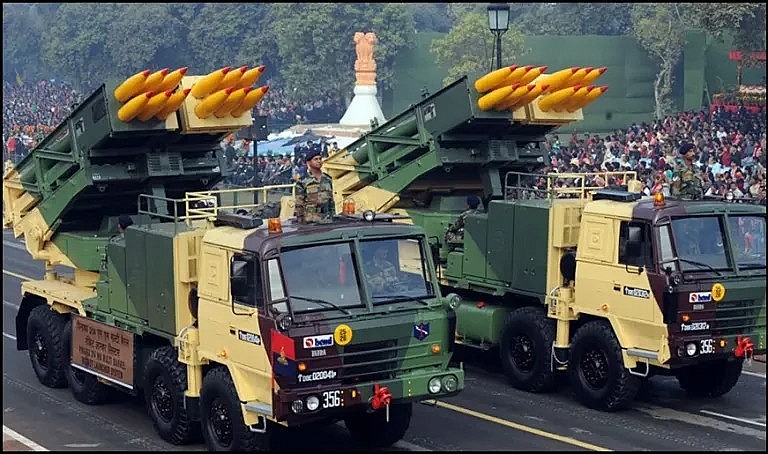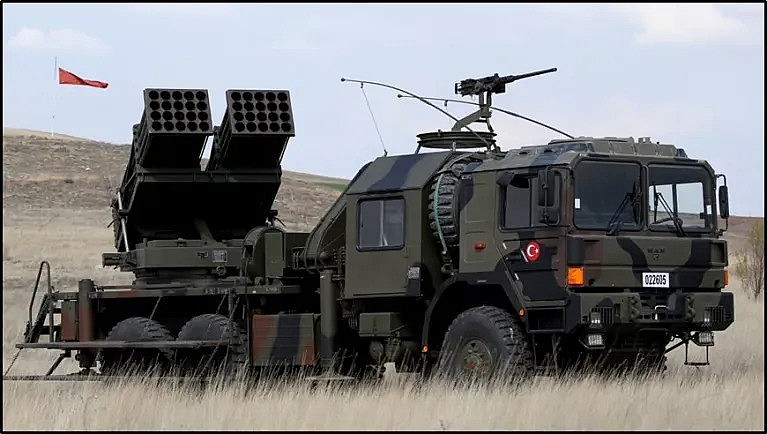Top 6 Multiple Launch Rocket Systems With The Greatest Power In The World
 |
| What Are The Most Destructive Multiple Launch Rocket Systems Today In The World? |
| Contents |
What Is A Multiple Launch Rocket System?
A Multiple Launch Rocket System or MLRS is a highly efficient and powerful weapon system designed to deliver e hit a specific target or target area with a barrage of rockets. These systems combine mobility, firepower and rapid deployment capabilities and pose as a significant upgrade in ground warfare.
It consists of a launcher mounted on a mobile platform generally tracked or wheeled which allows for quick mobilization and relocation. Unlike conventional artillery, MLRS have a much better specifics because of their effective range, faster fire rate, self-propelled characteristic, lower recoil, higher payload and much greater inaccuracy.
♦ TOS-1: Russia's most powerful non-nuclear weapon on the Ukrainian battlefield
Top 6 Most Destructive Multiple Launch Rocket Systems In The World
1. M270
Rate of fire – Full salvo of 12 rockets in under 60 seconds
Operational range – 500km
Crew – 3
Cost – $2.3 million per launcher unit (according to 1990s financial year report)
The M270 is the original version, which carries 12 rockets in two six-pack pods. This armored, tracked mobile launcher has a high cross-country capability and is built on a stretched Bradley chassis. M270A1 was developed as part of a 2005 upgrade program for the United States Army, and later for several other states. The launcher looks identical to the M270, but it has an improved fire control system (IFCS) and a launcher mechanical system (ILMS). This enables much faster launch procedures and the firing of GMLRS rockets with GPS guidance. The United States Army updated 225 M270s to this standard. When Bahrain ordered nine upgrades to "A1 minimum configuration" in 2022, it was stated that CFCS would be included.
READ MORE: How to Track Online A Huge Chinese Rocket that Fall to Earth
2. BM-30 Smerch
Rate of fire – A full salvo of 12 rounds in 38 seconds
Operational Range – 850km
Crew – 3
Cost – $12 million each unit
Despite its high unit cost, the BM-30 Smerch has a large number of foreign operators. Aside from Russia's 100+ units, Algeria, Belarus, and Azerbaijan each have 40+ units, and Morocco, Pakistan, and Kuwait each have 30+ units. Armenia, Kazakhstan, Syria, and Venezuela are among the countries that use them. The Indian Army employs the 9A52-2T Smerch launchers, a variant based on the Tatra 1010 chassis, and according to the most recent data, India has 372 of these. Ukraine has produced over 100 units of the Vilkha heavy MLRS based on the BM-30, while China manufactures the licensed-Smerch version known as the PHL-03.
3. Pinaka
Rate of Fire – 12 High Explosive Rockets in 44 seconds / 40 122mm cluster munition rockets in 20 seconds
Warheads – Anti-personnel and anti-tank rockets, cluster munition, High Explosive Fragmentation (HMX) rockets, High Explosive Incendiary Rockets (Warhead weight – 100kg – 250kg).
Operational Range – 800km
Crew – 5
Effective firing range – 35-70km
Cost – INR 430 crore ($54 million USD) per regiment
The Pinaka is equipped with an extremely capable MLRS-integrated radar guidance system. It includes Trajectory Correction System and Ring Laser Gyro Inertial Navigation with GPS/NaviC satellite guidance (ISRO's operational autonomous tracking satellite). As a result, its target accuracy range is as low as 7m CEP. The Pinaka can be operated in several modes: autonomous (under full automatic control of its Fire Control Computer), stand-alone (can be controlled and fired from a distance of 200m away from the system), remote (can be controlled and fired from a distance of 200m away from the system), and manual (fully operational even if there is no power to activate the microprocessor-based operator console). Pinaka is also equipped with night-vision capabilities. Pinaka, unlike most other MLRSs, can conduct missions accurately in sloped terrain and mountain tops due to extensive testing.
4. T-122 Sakarya
 |
Rate of fire – Full salvo of 80 rockets in 80 seconds
Warhead – Indigenous Turkish explosive rockets, High Explosive Fragmentation rockets, Cluster ammunition, anti-personnel and anti-tank submunitions.
Operational Range – 970km
Crew – 5
The Turkish variant of the BM-21 Grad is the T-122 Sakarya multiple launch rocket system. This system's prototype was revealed in 1995. The first vehicles were delivered to the Turkish Army in 1996 for trials and evaluation, and full-rate production began in 1997. The MKEM manufactures this artillery system locally. More than 72 systems had been delivered by 2008, and production is still ongoing. It is also recommended for export clients.
It is a self-propelled artillery rocket system that provides indirect fire support against aerial targets, enemy artillery units, air defense systems, command and control centers, and supply lines. It is most commonly used in hit-and-run attacks.
5. TOS-1
Rate of Fire – 30-rounds/15 seconds
Effective firing range – 5-10km
Operational range – 550m
Crew – 3
Cost – approximately $6.5-7 million per launcher unit
The TOS-1 or TOS-1A is a multi-barrel rocket launcher with 30 or 24 barrels containing thermobaric warheads. It was designed to target troops and forces in fortified positions, lightly armored vehicles, and open-area transports.
An ex-Indian Army officer, Lt Col JS Sodhi (Retd), explained that a thermobaric MLRS bomb uses oxygen from the surrounding atmosphere to produce an extremely high-temperature explosion, creating a kind of vacuum.
According to Sodhi, this weapon is "very dangerous" because the initial explosive charge detonates upon impact with the target, dispersing the fuel container with the surrounding oxygen and destroying everything in its vicinity.
| "These blast waves of a thermobaric weapon last longer than those of a conventional explosive," he continued. The purpose of these weapons is to specifically damage buildings, infrastructure, and enemy force personnel. Since the beginning of the all-out war in February 2022, the USSR and Russian military have used the TOS-1A weapon in conflicts such as Afghanistan, Chechnya, and, more recently, Ukraine. In addition, the United States used thermobaric weapons in the 1960s. |
6. M142 HIMARS
Rate of fire – A full salvo of 6 rockets in under 60 seconds
Operational Range – 480km
Effective firing range – 10-500km
Crew – 3
Cost – $4 million per unit
The HIMARS' pod has a 360-degree traverse feature, making it a very lethal system that can fire in any direction required. Furthermore, it has a remarkable accuracy of 1m CEP. The Airbus A400M Atlas and the Lockheed Martin C130 Super Hercules can transport it. It successfully demonstrated target-hitting aboard the deck of the USS Anchorage in October 2017, demonstrating its ability to deliver precision fire from a standoff range against shore defenses.
Since then, its targeting software has been improved to ensure maximum accuracy even while the launch platform is in motion. It enables all-weather network-centric operations for better battlefield collaboration.
Chinese rocket debris tracker: How to see location where it will land and When it will fall to Earth? Chinese rocket is expected to reenter ... |
 What Is Russia’s Poseidon Drone - 'Super Weapon of the Apocalypse' What Is Russia’s Poseidon Drone - 'Super Weapon of the Apocalypse' NATO has warned over the Russia’s nuclear submarine Belgorod, which can carry Poseidon torpedoes. Former US Assistant Secretary of State Christopher Ford called it ‘a ... |
 Top 10 Deadliest Biological Weapons In The World Top 10 Deadliest Biological Weapons In The World Biological weapons have the power to cause an epidemic and death to human. Check out which types of biological weapons are the most deadly. |
























